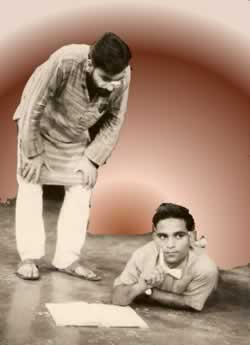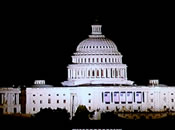For Whom Nobel’s Toll

Harold Pinter passed away on 24 December 2008. He was 78 and had been undergoing treatment for liver cancer. Like most Nobel prizes for Literature, the choice of the British playwright Harold Pinter has also had its share of detractors. There have been all kinds of murmurings against Pinter getting the big prize, ranging from doubts about his literary worth to snide remarks about extraneous considerations having played a role in the selection. The prize for the slyest reaction – assuming that it wasn’t the ghastly mistake it was made out to be – goes of course to the Sky Television newscaster who assumed that the breaking news about Pinter must have been to announce his demise (Pinter had taken a bad fall some days earlier) and therefore led off with an announcement that Pinter had died, before hesitating and then correcting herself to say that he had been awarded the 2005 Nobel Prize for Literature instead.
Well, to be honest, I’m not sure the word ‘instead’ was actually used, but given the bad grace with which his award has been received in some quarters, I wouldn’t be surprised if it was. It’s not difficult to figure out why Pinter’s selection has been met with churlishness. On the one hand, a body of mainstream taste has tended to deride Pinter’s theatre as just so much fluff. Pinter’s departures from staple theatrical modes have often been seen as a thinning out of the fundamentals of theatre, and even as evidence of his inability to get the basics right — much in the manner of the standard joke that Picasso’s cubism springs from his lack of talent at drawing like everyone else. Pinter’s technique of conjuring up dramatic tension and menace out of thin air, so to speak, has often provoked the incredulous suspicion that is bestowed upon all innovations and departures from the mainstream.
In recent years, Pinter’s political activism has provoked another kind of ire. The ill-tempered outburst of John Simon, an old Pinter baiter, on learning of Pinter’s Nobel prize, is interesting for the disarmingly guileless manner in which it reveals the prejudice that feeds its indignation. When Simon says, “I would have gladly accorded him the Nobel for Arrogance, the Nobel for Self-Promotion, or the Nobel for Hypocrisy – spewing venom at the United States while basking in our dollars – if such Nobels existed. But the Nobel for Literature? I think not”, he exposes the burr that’s actually prickling his behind.
Evidently, what has got Simon’s goat is not Pinter’s literary worthlessness, but the fact that the Nobel Prize for Literature was awarded to someone who has indefatigably campaigned against American and British adventurism in Bosnia, Afghanistan and Iraq, and has therefore shown himself to be of the ‘enemy camp’. Evidently, Simon’s tirade typifies the brand of opinion which wants artists to confine themselves to their work and desist from engaging in any form of activism, especially that which pits them against the weight of majoritarian opinion. (Perhaps this is why Arundhati Roy continues to raise the hackles of professional dabblers in that hallowed literary form, the Letters to the Editor.) And, evidently, Simon believes that he who pays pipers has the moral, nay spiritual, sanction to call the shots along with the tunes.
Nah, I shouldn’t trash letters to editors. For, how else could I have gleaned that lovely nugget of information, contributed by a reader to the Guardian, concerning “the sullen, deafening silence from Downing Street about the new British Nobel Laureate, Harold Pinter?” The British government’s wariness in celebrating the achievement of a countryman simply because of his vocal (and forgivably intemperate) criticism of state policy is just the kind of silence that would be familiar to Pinter, given the evocative treatment of silence in his plays. Of a piece with such silencing is an article lauding Pinter’s Nobel achievement that has been carried in the latest issue of Britain Today, a news magazine produced by the British High Commission in India. Unsurprisingly, it makes absolutely no mention of Pinter’s outspoken criticism of British foreign policy, a criticism that he has stuck to despite constant mockery and ridicule. How else can one read the title of that article, “Master of Silence”, except as a desperate act of wish-fulfilment!
Is one over-emphasising Pinter’s political stance as a factor in his getting the award and in the reactions to it? I don’t think so – and not simply because others have commented that the Swedish Nobel committee may have been inclined to favour a writer who has voiced his anti-war sentiments in no uncertain terms (Pinter has famously denounced Bush as a “mass murderer” and dismissed Blair as “that deluded idiot”), given the fact that the Swedish people too were extremely vocal in their anti-Iraq war protests. If this sounds like a slur on the literary credentials of Harold Pinter, it is interesting to see him make the same connection, albeit in a less whining tone: “Why they’ve given me this prize I don’t know. … But I suspect that they must have taken my political activities into consideration since my political engagement is very much part of my work. It’s interwoven into many of my plays.” That this is a man speaking with a modesty characteristic of the greatest writers is par for the course. But, it is unusual to find a writer who values his political conscience as much if not more than his writing, especially as even readers are often uncomfortable with such privileging.
It’s not as if Pinter needed the sympathy of political fraction. His credentials as a writer are justification enough for the Nobel award. He isn’t the writer of whom no one’s heard, as some previous Nobel awardees have been. Not when his plays are widely translated and performed in other languages; not when they pop up regularly in drama syllabi of Literature Departments; and certainly not when ‘Pinteresque’ is now staple lit-crit jargon for a patented blend of mundane but oblique dialogue, brooding silences and ineffable unease, all floating gingerly on a bed of sudden incongruity. (Anyway, what does the label “unheard-of author” mean? Surely, nothing more than the writer’s works having not been translated (yet) into English, and therefore being unfamiliar to the international publishing scene….)
Pinter is now 75 years old, with a long writing and performance career of considerable range and distinction. He has acted on stage, film, television and radio. He has written nearly thirty plays since 1957, and has innumerable drama sketches, poems and prose published in several volumes. He has directed over 25 productions of his own and others’ plays, adapted novels for the stage (notably Proust’s Remembrance of Things Past) and for film (for instance, Fowles’ The French Lieutenant’s Woman and Kafka’s The Trial), adapted his plays for radio and television, written over 20 screenplays (The Servant and The Go-Between, both directed by Joseph Losey, being two delightful instances), and is now so immersed in speaking out on political matters that earlier this year he spoke of not writing any more plays in order to focus his energy on such issues.
Initially, things didn’t look promising; Pinter didn’t burst in on the scene in the manner of other path-breaking dramatists. The 1956 commercial and critical success of Osborne’s Look Back in Anger, notwithstanding its combative indecorum, had suggested that British audiences were tiring of conventional fare, but Pinter’s first plays in 1957-58 (The Room, The Dumb Waiter and The Birthday Party) were received with bewilderment and hostility. (That this could happen despite the praise showered on the English premiere of Beckett’s Waiting for Godot in 1955 is curious, given the several affinities that have subsequently been noted between Beckett’s and Pinter’s theatrical worlds.) It wasn’t until 1960 that Pinter had his first success with The Caretaker. From then on, plays such as The Homecoming (1964),Landscape and Silence (1967 & 1968), No Man’s Land (1974) and Betrayal (1978)established Pinter’s reputation as a unique voice in contemporary theatre. To such an extent that The Dumb Waiter, along with Edward Albee’s The Zoo Story, soon became an absolute must-do for budding thespians in college theatre societies.
Pinter’s plays revolve typically around contestations for territory. Conflicts, sparked off by intrusions into a closed space by an outside force, are conducted with a strange mix of ferocity and dulled detachment. His characters and their dialogues are rarely explicated through conventional excavations of motivation and memory, and often viciousness and pain lurk submerged beneath an evasive surface composed of guilt, uncertainty, everyday phrases and restless silences. The ‘facts’ on which these contestations are pegged are usually unreliable, for there is little that is either ‘true or false’ in Pinteresque space.
The unnamed tension of these plays are located in such a claustrophobic, inter-personal space that Pinter’s writing has been criticized for turning its back upon the political, an impression that was confirmed when Martin Esslin included Pinter in his seminal study, The Theatre of the Absurd. However, the later plays – such as One for the Road (1984), Mountain Language(1988) and Ashes to Ashes (1996) – are more distinctly political. But, here too authoritarian structures of repression and torture are evoked rather than articulated, and filter through spare exchanges between oppressor and victim, and the slippages of memory and knowledge. Perhaps, this phase of Pinter’s writing is less a ‘shift’ from his early work than an extension of earlier preoccupations into a wider territory.
Though the Nobel citation – Pinter’s plays “uncover the precipice under everyday prattle andforce entry into oppression’s closed rooms” (my italics) – celebrates the dramatist as much as it does the political activist, the writer himself draws sufficient distinction between his preoccupations as an artist and as a “political intelligence” to not let the achievements of one absolve him of the responsibility enjoined upon the other. He recently had this to say of the road he’s travelled: “In 1958, I wrote, ‘there are no hard distinctions between what is real and what is unreal…. A thing is not necessarily either true or false; it can be both true and false.’ I believe that these assertions . . . do still apply to the exploration of reality through art. So as a writer I stand by them but as a citizen I cannot. As a citizen I must ask: What is true? What is false?”
In an interview some years ago, Pinter had rued the bane of British intellectual life being the mockery directed at artists who take a stand on political issues, and had warned, “Well, I don’t intend to simply go away and write my plays and be a good boy. I intend to remain an independent and political intelligence in my own right.” What lovelier spectacle can there be than this — of a dramatist, who goes on to win the Nobel Prize, acknowledging that conscientious citizenship is a more urgent cry than any artistic calling?
This article was published earlier in FIRST CITY (Dec 2006) after Pinter was awarded the Nobel Prize for Literature










